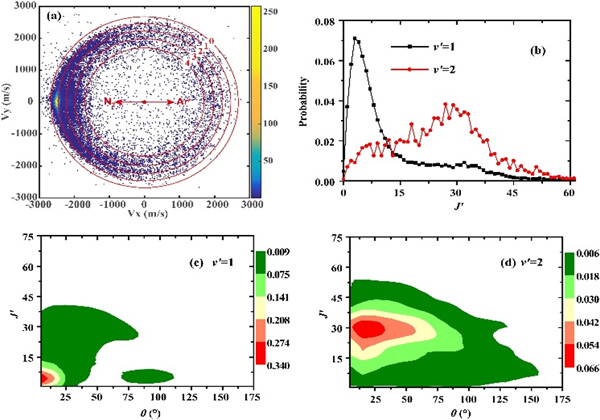News & Events
Research News
High-Resolution Scattering Imaging Reveals Vibrational-State-Specific Mechanisms in Charge-Transfer Reaction Ar+(2P3/2)+N2
Charged atomic and molecular species are ubiquitous in various environments like planetary atmospheres, interstellar medium and plasma. The collisions between charged ions and neutral molecules play vital roles in determining the chemical evolution and energy transfer in these complex gaseous environments. 
Ar++N2 → Ar+N2+ is a paradigmatic ion-molecule reaction, which has been intensively studied both experimentally and theoretically during the last half century. However, the underlying microscopic charge-transfer dynamics has not been fully understood yet. This is mainly due to the relatively low energy resolution achievable and the coexistence of both the spin-orbit ground Ar+(2P3/2) and excited Ar+(2P1/2) in the reactant ion beams in most previous experiments.
Recently, Prof. GAO Hong’s group from the Institute of Chemistry, Chinese Academy of Sciences (ICCAS) reinvestigated the charge-transfer reaction Ar+(2P3/2) + N2 → Ar + N2+(v′, J′) by using a home-build quantum-state-selected ion-molecule crossed-beam setup. This is accompanied by full-dimensional trajectory surface-hopping (TSH) calculations by Prof. GUO Hua and coworkers in the University of New Mexico, USA. This synergistic experimental and theoretical work identified two distinct charge-transfer mechanisms in the model reaction Ar++N2 → Ar+N2+.
The study entitled “Imaging of the charge-transfer reaction of spin–orbit state-selected Ar+(2P3/2) with N2 reveals vibrational-state-specific mechanisms” was published in Nature Chemistry (DOI: 10.1038/s41557-023-01278-y).
To gain deeper insights into ion-molecule reaction dynamics, the researchers in ICCAS designed and constructed a new ion-molecule crossed-beam scattering apparatus with a well-focused photoionization-based quantum-state-selected ion beam source and high-resolution three-dimensional (3D) velocity-map imaging (VMI) for detecting reaction products. The product velocity can be measured with a resolution better than 1.5%. The Ar+ ion was prepared exclusively in the spin-orbit ground state 2P3/2 by using the resonance-enhanced multiphoton ionization (REMPI) method. The ion beam was carefully focused into the reaction center, where it crossed with a supersonic N2 beam. The velocities of the charge-transfer product N2+ were measured by the 3D VMI system.
The relatively high resolution achieved in the experiment enables the product vibrational and rotational distributions and their correlations with the scattering angles to be measured accurately for the first time (Figure 1a). The full-dimensional TSH calculation semi-quantitatively reproduces the experimental measurements (Figures 1b-d). Novel vibrational-state-specific charge-transfer mechanisms have been clearly revealed. For the v′=1 vibrational level of N2+, the well-known long-distance harpooning mechanism dominates, which results in strong forward scattering with low rotational excitation (Figure 1c). For v′=2, strong rotational excitation is found in the forward scattering region (Figure 1d), contradicting the well-known hard sphere scattering model. The TSH calculation finds that it is due to the hard-collision glory scattering (HCGS) mechanism, which results from the delicate balance between the long-range attraction and short-range repulsion of the collisional partners.
This work demonstrated that the same level of quantum state-to-state understanding reached for neutral-neutral scattering in crossed-beam experiments is also achievable for ion-molecule scattering.

Figure 1. N2+(v′, J′) product scattering image (a), calculated rotational distributions (b) and their correlations with scattering angles for v′=1 (c) and v′=2 (d) (Image by Prof. GAO)
Contact:
Prof. GAO Hong
Email: honggao2017@iccas.ac.cn





